Taking Flight at the Migratory Bird Festival
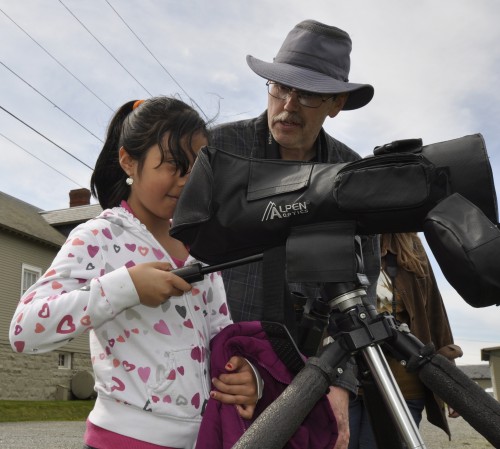
By Erica Keene
Smiles, laughter and flapping arms – I mean, wings. Yes, wings. These were the best parts of a sun-filled weekend spent learning about migratory bird species during the fifth annual Migratory Bird Festival at Ebey’s Landing National Historical Reserve. On Saturday, April 26, over 120 participants took on the role of migratory birds to learn about the difficulties they face during their winged travels. Their goal? Get safely to their next stop along the migration route.
The first round was easy, no obstacles. In the second round, a hunter was introduced. With each successive round, migration became harder and harder. Habitats began to disappear. Predators started increasing and catching larger numbers of birds. Elders, teens and little ones alike all participated in this lively, competitive game to learn just how many challenges birds face when migrating long distances.
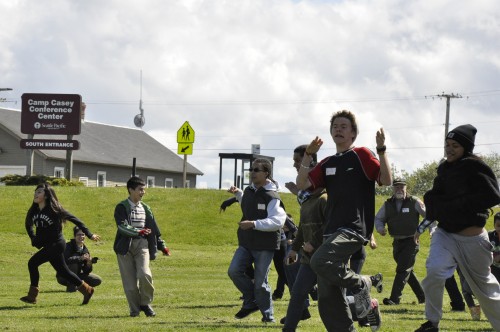 Youth from Seattle Parks & Recreation’s Outdoor Opportunities Program and the Kulshan Creek Neighborhood Program attempt to migrate safely to their next location while facing challenging obstacles such as hunters and habitat loss. Photo by author.
Youth from Seattle Parks & Recreation’s Outdoor Opportunities Program and the Kulshan Creek Neighborhood Program attempt to migrate safely to their next location while facing challenging obstacles such as hunters and habitat loss. Photo by author.
Groups rotated through three stations where they learned bird identification techniques, discovered ways to help conserve birds at home and participated in the ever-popular migration game. Each group adopted a bird for the day and spent time at each station learning fun facts about the Mallard, Rufous Hummingbird or the Killdeer. Some participants were even able to spot their bird during the bird identification station.
The day ended with students writing and decorating a postcard to be mailed to them in a few weeks’ time and with presentations on their adopted birds. Groups led interactive presentations on the Killdeer’s broken-wing display and the Rufous Hummingbird’s flight patterns while others absorbed the sunshine and listened.
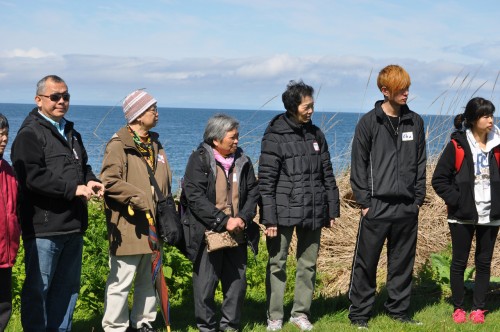 Elders and youth from InterIm Community Development Association learn about migratory bird conservation. Photo by: Jim Chu, USFS.
Elders and youth from InterIm Community Development Association learn about migratory bird conservation. Photo by: Jim Chu, USFS.
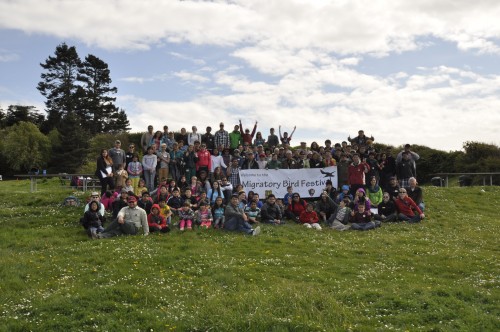 Over 120 participants gathered on Saturday in celebration of International Migratory Bird Day at Camp Casey. Coupeville, WA. Photo by author.
Over 120 participants gathered on Saturday in celebration of International Migratory Bird Day at Camp Casey. Coupeville, WA. Photo by author.
A handful of regional community and environmental organizations participated in this event in celebration of International Migratory Bird Day, including Seattle Parks and Recreation’s Outdoor Opportunities Program (O2), InterIm Community Development Association, North Cascades Institute’s Youth Leadership Adventures and the Kulshan Creek Neighborhood Program.
On Saturday evening, 23 youth from Seattle Parks & Recreation’s O2 program and InterIm Wilderness Inner-city Leadership Development (WILD) stayed the night at Camp Casey on Whidbey Island in anticipation of a Sunday stewardship project. Pacific Northwest Trail Association Intern, Noah Pylvainen, took students on a walk along the Pacific Northwest Trail and introduced students to the idea of long-distance backpacking.
 Youth Leadership Adventures students showing off their migratory bird postcards. Photo by Aneka Singlaub.
Youth Leadership Adventures students showing off their migratory bird postcards. Photo by Aneka Singlaub.
The next morning, students loaded onto the bus for a short trip to Fort Ebey State Park. Upon arrival, Operations Manager Craig Holmquist from the National Park Service introduced them to Ebey’s Landing National Historical Reserve. Students were given a demonstration on how to use a weed wrench and learned to identify Scotch broom: a tall, quick-to-spread invasive weed. Their task? Pull as much Scotch broom as possible out of the ground in just under three hours. Many youth had been to this event the previous year and were eager to get started. They looked at the area they cleared last year and when they realized none of it had grown back, huge smiles spread across their faces as the impact they were making started to seem more of a reality. This year, inn less than three hours, 23 youth and their adult leaders cleared nearly an acre of the invasive, yellow-flowered plant, an act of stewardship that will be appreciated by native plant aficionados to come.
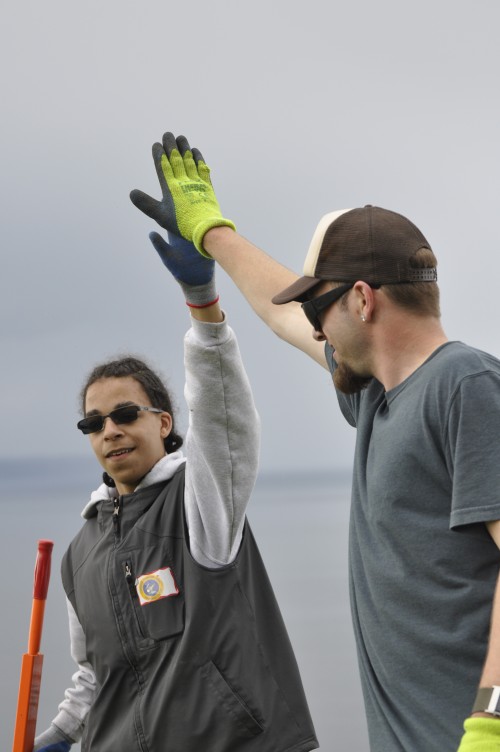 Zheonte Payne, 15, and Seth Wendzel from O2 share a high five in celebration of removing a particularly large Scotch Broom plant.
Zheonte Payne, 15, and Seth Wendzel from O2 share a high five in celebration of removing a particularly large Scotch Broom plant.
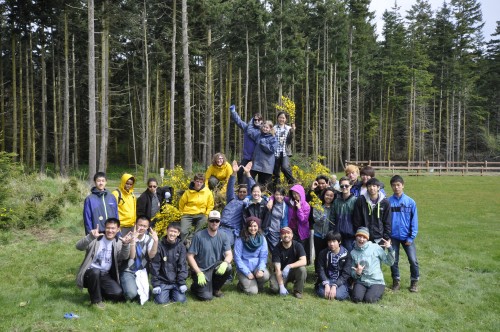 After nearly three hours of grueling effort, youth celebrate the two trailer loads of Scotch Broom they removed from Fort Ebey State Park. Photo by author.
After nearly three hours of grueling effort, youth celebrate the two trailer loads of Scotch Broom they removed from Fort Ebey State Park. Photo by author.
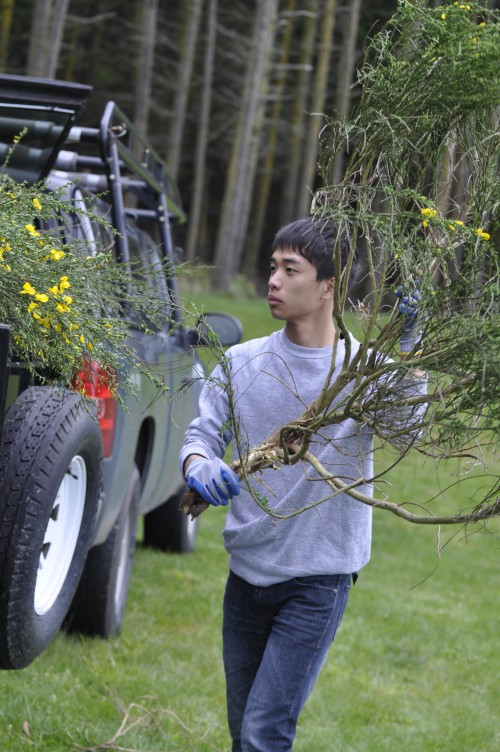 Lewen Chen, 17, from InterIm WILD loads Scotch Broom into a trailer to be removed from Fort Ebey State Park.
Lewen Chen, 17, from InterIm WILD loads Scotch Broom into a trailer to be removed from Fort Ebey State Park.
Thank you to the US Forest Service, Ebey’s National Historical Reserve, Ebey’s Trust Board, National Park Service, Skagit Audubon Society, Whidbey Audubon Society and all other staff and volunteers who helped make this event possible. We could not have done it without you!
Leading photo: Ximena Beccera, age 9, from the Kulshan Creek Program, learns how to use a spotting scope for the first time at the bird identification station.Erica Keene is the Youth and Community Engagement Coordinator of the Mt. Baker-Snoqualmie National Forest.

